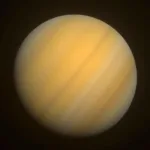Neptune, the eighth planet from our sun, is a captivating ice giant known for its striking blue hue. But what exactly gives Neptune its blue color? The answer lies in the composition of its atmosphere and how it interacts with sunlight.
Similar to what is the color of all the planets, this mesmerizing color isn’t due to the presence of liquid water. Instead, it’s the result of the absorption of red and orange light by methane in Neptune’s upper atmosphere. Let’s delve deeper into the science behind Neptune’s distinctive appearance.
The Role of Methane in Neptune’s Blue Hue
Methane, a simple hydrocarbon molecule, absorbs red and infrared light from the sun. This means that the red portions of sunlight are soaked up by the methane in Neptune’s atmosphere, while the blue and green portions are reflected back into space. This phenomenon, coupled with other atmospheric components, is what makes Neptune appear vividly blue to our eyes.
How Does Methane Absorb Light?
Methane molecules vibrate at specific frequencies. When sunlight, which contains a spectrum of colors, reaches Neptune’s atmosphere, the methane molecules absorb the red light, matching their vibrational frequency. This absorption leaves behind the blue and green wavelengths, which are then scattered back, giving Neptune its characteristic color.
Other Contributing Factors to Neptune’s Appearance
While methane is the primary driver of Neptune’s blue color, it’s not the only factor. High-altitude clouds, composed of ice crystals and other particles, also play a role in scattering sunlight and contributing to the planet’s overall appearance. These clouds can appear white or slightly yellowish, adding depth and complexity to the blue backdrop. This complex interplay creates the swirling patterns and varying shades of blue we see in telescopic images of Neptune.
 Neptune's Methane Absorption and Blue Color
Neptune's Methane Absorption and Blue Color
Comparing Neptune’s Blue with Uranus’s Blue-Green
Both Neptune and Uranus are ice giants with methane in their atmospheres, yet Uranus appears more of a blue-green color. This difference in hue is due to the relative concentrations of methane and other atmospheric components. Uranus has a lower concentration of methane than Neptune, leading to less absorption of red light and a resulting blue-green hue. This subtle difference highlights the complex interplay of atmospheric chemistry and how it shapes the appearance of these distant worlds. Understanding these differences is crucial to comprehending the unique characteristics of each planet.
Why is Neptune Bluer than Uranus?
While both planets have methane, Neptune’s atmosphere has a higher methane concentration. This increased methane absorption results in a deeper, more vivid blue color compared to Uranus’s lighter, blue-green shade.
What Gives Neptune its Dark Spots?
Besides its vibrant blue color, Neptune is also known for its dark spots, which are storm systems similar to Jupiter’s Great Red Spot. These dark spots represent areas of intense atmospheric activity and are thought to be caused by upwelling gases from deeper within the planet’s atmosphere. The exact mechanisms behind their formation and evolution are still being investigated, making them a fascinating area of ongoing research.
This is similar to what color are the planets, where atmospheric composition dictates color perception.
Conclusion: A Symphony of Light and Atmospheric Chemistry
Neptune’s breathtaking blue color is a testament to the complex interactions between sunlight and its atmospheric composition. The absorption of red light by methane, combined with the scattering of blue and green light, creates the distinctive hue that characterizes this distant ice giant. Understanding the factors that contribute to Neptune’s appearance allows us to appreciate the intricate beauty and scientific wonders of our solar system. So, the next time you see an image of Neptune, remember the fascinating dance of light and molecules that gives it its captivating blue color. For further exploration, check out de q color son los planetas.
FAQ
- What is the main component responsible for Neptune’s blue color? Methane.
- Why is Neptune bluer than Uranus? Neptune has a higher concentration of methane.
- What are the dark spots on Neptune? Storm systems.
- What colors of light are reflected by Neptune’s atmosphere? Blue and green.
- What type of planet is Neptune? An ice giant.
- What is the chemical formula of methane? CH4.
- What other atmospheric components contribute to Neptune’s appearance? High-altitude clouds.
Exploring further, you might also be interested in what is the color of planets. Consider these related questions: how does the distance from the sun affect a planet’s temperature, and what is the composition of Neptune’s core? This leads us to de q colores son los planetas for a broader understanding.
Need support? Contact us 24/7: Phone: 0373298888, Email: [email protected], or visit us at 86 Cầu Giấy, Hà Nội.
